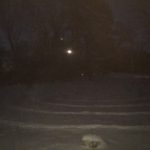Winter is the season of cold and darkness but there’s no reason to stay inside. It’s an outstanding time to enjoy the yard, a wetland, or a nearby woods, and these places are even more fascinating after dark than they are by day. Just use your night vision.
Winding Pathways encourages everyone to bundle up and go outside, especially after January or February’s darkness descends. Perhaps coyote songs or the haunting call of a barred owl will greet an intrepid nighttime listener.
There are some ways to best enjoy the darkness. Forget the flashlight. Well, maybe tuck it into a pocket but mostly keep it off. The best way to degrade night vision is using artificial light. Better to learn how to see in the dark.
Color Deficiency Can Help with Night Vision
Rich Patterson, a co-owner of Winding Pathways is lucky, sort of. He is unable to see the color red well. He’s not color blind as he can see blue, yellow, green, and some red shades, but he doesn’t see red as people with normal color vision so. For some reason, folks with color deficiency vision often have an outstanding ability to see after dark, and Rich enjoys his night vision, is often outside after dark, and hardly ever uses a flashlight.
There’s more to seeing after dark than having a color deficiency and better than average night vision. Everyone can use these techniques to negotiate the night and their homes at night without a flashlight.
Relax the eyes. Forget peering for detail, like the texture of a tree’s bark. Rather look out of the edges of the eyes for patterns that indicate a tree, rock, lawn, or some other object. Once the eyes are trained to work well at night it’s amazing how easy it is to walk a forest path, without a flashlight on a dark night. Or navigate your home in the dark and when the electricity goes off.
Foot Gear for Outdoor Walking
When outside, wear soft-soled shoes or in warm months, go barefoot. Thick hard-soled shoes, like hiking boots, make it impossible to feel the ground’s texture. Softer, pliable soles help a walker feel the trail. Native Americans knew this well and felt their way through dark forests through the soles of their moccasins.
It helps to mute electric lights in the house before venturing outdoors after dark. It takes a few minutes in darkness for eyes to adjust and allow more light to strike the retina.
Moon Shadows
There is a surprising amount of light on a dark night especially in winter with snow on the ground. Even in the dark of the moon, stars cast enough light on a clear night for an adept human to walk without a flashlight. With a waxing or even waning full moon, plenty of light is cast on the ground for us to see. The moon’s reflection even casts shadows: Moon shadows!
Pre-Dawn Labyrinth Walking
Since late December 2017, Marion has walked the Phoenix Harmony Labyrinth every day and mostly in the early morning. In cold, wind, full-moon and dark of the moon, fog, and snow, she has quietly trod through the snow, watched the stars, noted animal tracks and generally enjoyed this interlude in the dark.
Cave Dark is Real Dark
An interesting experience is taking a cave tour. Visit Carlsbad Caverns, Mammoth Cave, or nearly any other cave and invariably the guide will gather everyone and turn off the lights. Down in a cave there is no light at all. When there’s no light it’s impossible to see, but fortunately, a backyard or woods at night is much lighter than the depths of a cavern, so seeing is possible.
Go outside after dark and have fun.


